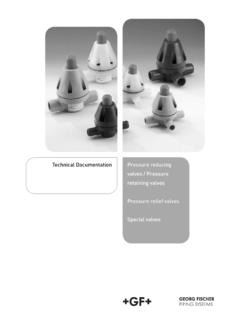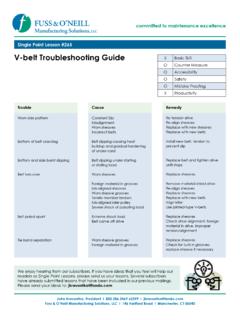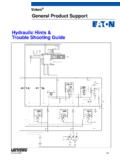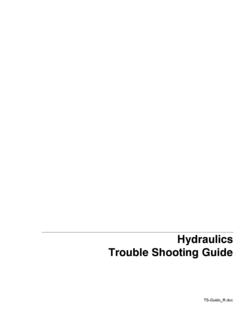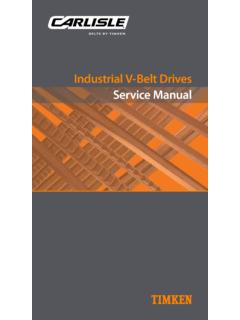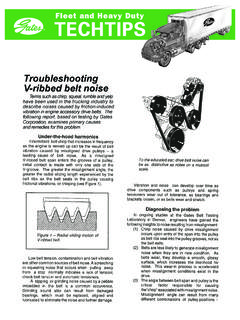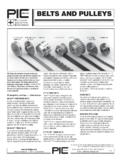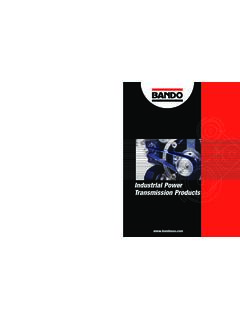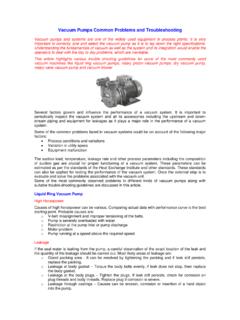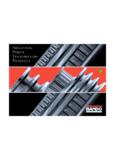Transcription of BELT DRIVE PREVENTIVE MAINTENANCE AND SAFETY …
1 belt DRIVE PREVENTIVE MAINTENANCE AND SAFETY OF CONTENTSS afety Policy ..1 Sources of DRIVE Problems ..2 PREVENTIVE MAINTENANCE ..3 SAFETY ..4 DRIVE Shutdown & Thorough Inspection Simple Inspection ..5 PREVENTIVE MAINTENANCE Checklist ..6 PREVENTIVE MAINTENANCE Procedure ..7 Measuring belt Tension ..8 Installation ..14 belt Storage & Handling ..18 belt Identification ..20 belt Types ..25 belt Styles ..28 Static Conductive Belts ..30 belt DRIVE Performance ..31 Noise ..33 Sprocket Corrosion Prevention ..35 Troubleshooting Guide ..37 Problem/Solution Summary Table ..39 MAINTENANCE Tools ..48 Technical Information ..51 NEMA Minimum Diameters ..52 Minimum Recommended Diameters ..54 Installation & Tensioning Allowances ..56 Idler Hardware ..60 DRIVE Survey Worksheet High Speed ..63 Low Speed ..64 Design IQ ..65 Trademarks & Warranty ..66 Copyright 2013 Gates CorporationDenver, Colorado 80217-58871 Warning! Be Safe!
2 Gates belt DRIVE systems are very reliable when used safely and within Gates application recommendations . However, there are specific USES THAT MUST BE AVOIDED due to the risk of serious injury or death . These prohibited misuses include:Primary In-Flight Aircraft SystemsDo not use Gates belts, pulleys or sprockets on aircraft, propeller or rotor DRIVE systems or in-flight accessory drives . Gates belt DRIVE systems are not intended for aircraft use .Lift SystemsDo not use Gates belts, pulleys or sprockets in applications that depend solely upon the belt to raise/lower, support or sustain a mass without an independent SAFETY backup system For applications requiring special Lift or Proof type chains with minimum tensile strength or certified/test tensile strength requirements, be advised that because Gates belts have different DRIVE design procedures from metal chains, the tensile strength of a belt when compared to the tensile strength of a chain should only be a part of the design process.
3 Diligent analysis with the customer s participation should be sued when considering any such application .Braking SystemsDo not use Gates belts, pulleys or sprockets in applications that depend solely upon the belt to slow or stop a mass, or to act as a brake without an independent SAFETY backup system . Gates belt DRIVE systems are not intended to function as a braking device in emergency stop systems . SAFETY POLICYD rive design software can be found at software assists designers in quickly selecting optimum DRIVE solutionsDRIVE DESIGN SOFTWARE2 SOURCES OF DRIVE PROBLEMSI mproper belt or Pulley InstallationEnvironmental FactorsPoor DRIVE DesignImproper belt Storage or HandlingDefective DRIVE ComponentsImproper DRIVE MaintenanceWhy have a PREVENTIVE MAINTENANCE program?When compared to the constant lubrication problems associated with chain drives, or the mechanical problems and high costs associated with gear drives, belts are the most cost-effective, reliable means of power transmission.
4 However, optimum belt DRIVE performance requires proper MAINTENANCE . The potential for long service life is built into every Gates belt . When coupled with a regularly scheduled MAINTENANCE program, belt drives will run rela-tively trouble-free for a long time .Important to your businessAn effective PREVENTIVE MAINTENANCE program saves time and money . Inspecting and replacing belts and faulty DRIVE components before they fail will reduce costly downtime and production delays .What is a good belt MAINTENANCE program?A comprehensive, effective program of PREVENTIVE mainte-nance consists of several elements: Maintaining a safe working environment . Regularly scheduled belt DRIVE inspections . Proper belt installation procedures . belt DRIVE performance evaluations . belt product knowledge . belt storage and handling . Troubleshooting . PREVENTIVE MAINTENANCEBelt DRIVE should have adequate guardCarefully inspect all belts* Note - If belt looks bad, it probably is3 Power should be shut off and controls locked before inspectingMaintaining A Safe Working EnvironmentIt is common sense to establish a safe working environment in and around belt drives.
5 The following precautions will make belt DRIVE inspection and MAINTENANCE easier and safer .Wear Proper ClothingNever wear loose or bulky clothes, such as neckties, exposed shirttails, loose sleeves or loose lab coats around belt drives . Remove jewelry and tie up or restrain long hair . Wear gloves while inspecting sheaves or sprockets to avoid being cut by nicks, burrs or sharply worn pulley edges . Wear SAFETY glasses to avoid eye injuries . Don t be foolish! Wear proper clothing . Always wear proper personal protective equipment, including gloves, eye & ear protection, steel toe shoes, and a hard hat .Maintain Safe Access to DrivesAlways maintain safe access to the belt drives . Keep area around drives free of clutter, debris and other obstructions . Floors should be clean and free of oil and debris to insure good footing and balance while working on machinery . DRIVE GuardsAlways keep drives properly guarded . Every belt DRIVE must be guarded when in operation.
6 Guard must be designed and installed according to OSHA standards . A Properly Guarded belt DriveA properly designed guard has the following features: Completely encloses DRIVE . Grills or vents for good ventilation . Accessible inspection door or panels . Can easily be removed and replaced if damaged . Where necessary, should protect the DRIVE from weather, debris and damage .Follow these precautions to make your PREVENTIVE MAINTENANCE easier. SAFETY4A properly guarded belt driveDon t clutter area around belt driveNo loose or bulky clothing. This technician s bulky lab coat is a hazard near moving componentsPower should be shut off and controls locked before inspectingSimple DRIVE InspectionBegin PREVENTIVE MAINTENANCE with a periodic DRIVE inspec-tion as a normal part of your MAINTENANCE rounds . Look and listen for any unusual vibration or sound while observing the guarded DRIVE in operation . A well designed and maintained DRIVE will operate smoothly and quietly.
7 Inspect guard for looseness or damage . Keep it free of debris or dust and grime buildup on either the inside or the outside of the guard . Any accumulation of material on the guard acts as insulation, and could cause drives to run hot-ter . The effect of temperature on belt life is important . For example, an internal temperature increase of 18 F (or approximately 36 F rise in ambient DRIVE temperature) may cut belt life in half . Beware of hot surfaces and the potential for injury .Also look for oil or grease dripping from guard . This may indicate over-lubricated bearings . If this material gets on rubber belts, they may swell and become distorted, leading to early belt failure .It s a good idea to check motor mounts for proper tightness . Check take-up slots or rails to see that they are clean and lightly lubricated .How Often To InspectThe following factors influence how often to inspect a DRIVE . Critical nature of equipment DRIVE operating cycle Accessibility of equipment DRIVE operating speed Environmental factors Temperature extremes in environmentExperience with specific equipment is the best guide to how often to inspect belt drives.
8 Drives operating at high speeds, heavy loads, frequent stop/start conditions and at tempera-ture extremes or operating on critical equipment require frequent inspection .When To Perform PREVENTIVE MaintenanceTo help establish a PREVENTIVE MAINTENANCE schedule, keep the following in mind .Critical DrivesA quick visual and noise inspection may be needed every one to two weeks .Normal DrivesWith most drives, a quick visual and noise inspection can be performed once a month .Complete InspectionA DRIVE shutdown for a thorough inspection of belts, sheaves or sprockets and other DRIVE components may be required every three to six months .Remember, a well-designed industrial belt DRIVE is capable of operating for several years when properly maintained and used under normal conditions .Follow the PREVENTIVE MAINTENANCE Procedure on the fol-lowing page when performing detailed MAINTENANCE during equipment shutdowns . DRIVE SHUTDOWN & THOROUGH INSPECTION5 DRIVE SHUTDOWN & THOROUGH INSPECTION6 PREVENTIVE MAINTENANCE Check ListBy following these steps, belt drives can be maintained efficiently and safely.
9 1. Always turn off the power to the DRIVE . Lock the con-trol box and tag it with a warning sign Down For MAINTENANCE . Do Not Turn Power On . Make sure the power is turned off for the correct DRIVE . Never have contact with a belt DRIVE unless the system is tagged and locked Test to make sure correct circuit has been turned off .3. Place all machine components in a safe (neutral) position . Make sure that moving components are locked down or are in a safe position . Make sure that fans cannot unexpectedly freewheel .4. Beware of pinch points . Keep hands and fingers clear, especially where belts enter sheaves and sprockets .5. Remove guard and inspect for damage . Check for signs of wear or rubbing against DRIVE components . Clean and realign guard to prevent rubbing if neces-sary .6. Inspect belt for wear or damage . Replace as needed . 7. Inspect sheaves or sprockets for wear and misalign-ment . Replace if worn .8.
10 Inspect other DRIVE components such as bearings, shafts, motor mounts and take-up rails .9. Inspect static conductive grounding system (if used) and replace components as needed .10. Check belt tension and adjust as needed .11. Recheck sheave or sprocket alignment .12. Reinstall belt guard .13. Turn power back on and restart DRIVE . Look and lis-ten for anything unusual .Turn off power, lock controls and tagDRIVE SHUTDOWN & THOROUGH INSPECTION7 PREVENTIVE MAINTENANCE ProcedureOnce the power is off, locked and tagged, and the machine components are in safe positions, remove the guard and begin the inspection .How to Inspect a BeltObserving signs of unusual belt wear or damage will help troubleshoot possible DRIVE problems .Mark or note a point on the belt , or on one of the belts in a multiple V- belt DRIVE . Wearing gloves, work around the belt (s), checking for cracks, frayed spots, cuts, or unusual wear patterns . Beware of pinch points.

